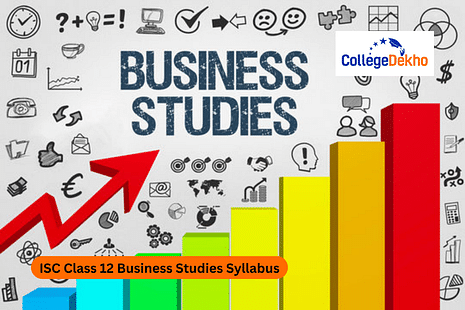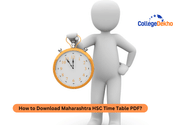- ISC Board Class 12 Business Studies Syllabus 2025-26: Download PDF
- ISC Board Class 12 Business Studies Syllabus 2025-26 Course Structure
- ISC Class 12 Business Studies Project Work 2025
- ISC Class 12 Business Studies list of suggested Projects
- How To Download ISC Board Class 12 Business Studies Syllabus …
- ISC Class 12 Business Studies 2025 Paper Pattern
- ISC Class 12 Business Studies 2025 Reference Books


Never Miss an Exam Update
ISC Board Class 12 Business Studies Syllabus 2025-26: The Council for Indian School Certificate Examinations has released the ISC Board Class 12 Business Studies Syllabus 2025-26. The syllabus is designed to provide students the knowledge of entrepreneurship, business operations, and management. The total marks for the Business Studies exam are 100 divided into two parts - theory and project work. Theory paper carries 80 marks and project work is for 20 marks. Students can go through the Business Studies syllabus in detail to refer to the topics to be covered for board exams. In addition to the topics, students can also check the marking scheme followed by the ISC board.
ISC Board Class 12 Business Studies Syllabus includes 5 chapters in total. The theory paper will be of 80 marks in total. In addition, students will have to work on a project worth 20 marks. In this article, students can get information about the chapters included in the ISC class 12 Business Studies syllabus 2025-26. Read the entire article and get the link to download the ISC class 12 Business Studies syllabus PDF.
ISC Board Class 12 Business Studies Syllabus 2025-26: Download PDF
Click on the link given below to download the ISC Board Class 12 Business Studies Syllabus 2025-26 PDF:
| ISC Board Class 12 Business Studies Syllabus 2025-26 PDF |
|---|
ISC Board Class 12 Business Studies Syllabus 2025-26 Course Structure
Students can check the following details to get the detailed ISC board Class 12 Business Studies Syllabus 2025-26. They can divide the chapters into different sections while preparing for the board exams. Students can visit the official website at https://www.cisce.online/ and verify the syllabus. They can prepare a study plan according to their caliber after looking at the syllabus mentioned below:
- Human Resource Management
(i) Introduction to Human Resource Management.
Meaning and definition of Human Resource Management; Characteristics of Human Resource Management: people oriented, comprehensive function, staff function, pervasive, challenging, continuous, individual oriented, development oriented, action oriented, future oriented, interdisciplinary, art as well as science, young discipline; Importance of human resource management.
(ii) Job and Manpower planning.
Meaning, relevance and difference between the following: Job Analysis, Job Specification, Job Description, Job Enrichment and Job Enlargement, Manpower Estimation.
(iii) Staff Recruitment.
Meaning, definition and characteristics of staff recruitment; sources of recruitment; internal sources (promotion, transfer, ex-employees, recommendation by employees); external sources (advertisements, campus recruitment, casual callers, gate hiring, employment exchanges, placement agencies, labour contractors).
Differences between internal and external sources of recruitment, their merits and demerits; e-recruitment: concept, benefits and limitations; sources of e-recruitment: internet and intranet.
(iv) Staff Selection.
Meaning and definition of staff selection; selection procedures (preliminary screening, application blank, selection test, Group discussion, final interview, medical test, reference check, final approval, placement; brief explanation and importance of each step of the selection procedure); distinction between recruitment and selection.
(v) Staff Training.
Meaning and definition of training; distinction between training, education and development; types of training (induction, job, remedial, safety, promotional, refresher; brief explanation of each.); methods of training: on the job and off the job (vestibule, apprenticeship, internship, classroom); distinction between on the job and off the job training.
Hindrances to training: brief explanation. Benefits of training to employer and employees.
(vi) Staff Morale.
Meaning, definition and characteristics of staff morale; Morale Productivity Matrix (brief explanation of the four situations); factors influencing morale (morale depressants and stimulants: an understanding of how the same factor may lower or boost morale); methods of raising morale; indicators of low and high morale; advantages of high morale; disadvantages of low morale.
(vii) Staff Motivation.
Meaning, definition and characteristics of staff motivation; difference between motivation and morale; importance of staff motivation; factors influencing motivation: monetary and non-monetary incentives; differences between monetary and non-monetary incentives; Maslow’s theory of the Hierarchy of Human Needs - explanation of the theory with the help of the pyramid, assumptions and criticism of the theory; Herzberg’s Two-factor Theory (Motivation and Hygiene Factors).
(viii) Staff Remuneration.
Meaning and definition of Staff remuneration, Methods of wage payment - Time Rate and Piece Rate System (An explanation of the two systems along with their merits, demerits and suitability, differences between the two); Pay Slip and Payroll - Meaning, Differences, Components, Specimens of both. Various staff benefits: Employee Provident Fund, National Pension System, Group Insurance (medical and life), encashment of leave, gratuity, (basic understanding only).
Types of leaves (casual, medical/sick, earned / privilege, maternity/paternity, sabbatical/study, leave without pay: basic understanding only)
(ix) Staff Leadership.
Meaning and definition of staff leadership; distinction between Leadership and Management; leadership styles: Autocratic, Democratic, Laissez-Faire (brief explanation, advantages, disadvantages and comparison between each style); Leadership continuum (the concept of situational leadership to be explained briefly); Blake & Mouton Managerial Grid (brief explanation).
(x) Staff Appraisal.
Meaning and definition of Performance Appraisal and Potential Appraisal; distinction between the two; Objectives and importance of Performance Appraisal, Methods of Performance Appraisal - merit grading, appraisal by results, appraisal by superior staff: self-appraisal; 360° appraisal (brief explanation of each method and their respective advantages and disadvantages).
(xi) Staff Promotion and Transfer.
Staff Promotion - Meaning, definition, benefits and limitations of promotion; Open and Closed policy of promotion (meaning and differences); a brief understanding of the concept of Dry promotion and upgrading; requirements of a sound promotion policy; basis of promotion: seniority, merit, seniority-cum-merit (brief explanation of each and the advantages, disadvantages, comparison between seniority basis and merit basis.)
Staff Transfer - Meaning, definition and need for transfer. Types of transfers: replacement, versatility, remedial, production (meaning and relevance of each type).
(xii) Staff Separation.
Meaning of Staff separation; means of staff attrition: Retirement (Compulsory and Voluntary), Lay off, Retrenchment, Resignation, Suspension, Dismissal: grounds for dismissal (Meaning and distinction only).
Exit Interview - Meaning and importance.
(xiii) Emerging trends in Human Resources.
Flexible Hours, Permanent part time, Work from home, Retainership, Virtual teams, Self-managing teams (SMTs) - only meaning of the above terms.
- Business Communication and Correspondence
(i) Business Communication
Meaning and definition of communication; importance of communication in business, elements of the Communication Process, Methods of communication: Oral, Written, Gestural, Visual (Meaning, advantages and disadvantages of all these methods), Difference between oral and written communication, Types of communication: On the basis of area of operation (Internal and External), on the basis of relationship (Formal and Informal), on the basis of direction (Horizontal, Vertical and Diagonal, upwards and downwards), Meaning, Advantages and Disadvantages of each; distinction between - Internal and External; Formal and Informal; Horizontal and Vertical Communication; barriers to Communication (Semantic, Physical and Mechanical, Organisational, Socio-Psychological: meaning only, detailed explanation not required); overcoming the barriers to communication.
(ii) Business Correspondence
Need and functions of business correspondence.
Business Letters
Elements and contents of various business letters; types of letters: solicited and unsolicited letters of application for a job, along with drafting of biodata; Interview letter, Offer of Appointment, Letter of enquiry, Quotation letter, Order letter, Complaint letter, Reply to Complaint letter).
Reports
Meaning and definition of Reports; types of reports: statutory, non- statutory, private, public, informational, interpretative, routine/periodic, special; brief explanation of each type of report; differences between statutory and nonstatutory, private and public, informational, routine / periodic and special report. Format of report (report writing not required).
(iii) Current trends in Business Communication: e-mail and video conferencing.
Meaning and uses of e-mail and video conferencing.
- Business Size and Finance
(i) Various business entities.
Meaning, definition and distinction between sole proprietorship, partnership, private limited company and public limited company.
(ii) Sources of business finance
A basic understanding of the following: Equity and preference shares, debentures and bonds, retained profits, public deposits, loans, trade credit, discounting of bills of exchange, global depository receipt, Angel investors, venture capitalists, crowd funding, peer to peer funding, factoring.
- Globalisation and recent trends in Business
(i) Globalisation.
Meaning, nature, opportunities and threats of globalization for business; brief understanding of how globalization has been instrumental in transforming the manner in which Business is conducted.
(ii) e-Business.
Meaning, nature and importance of e-business to the buyer and to the seller.
(iii) Outsourcing.
Concept of outsourcing; parties involved - the outsourcer, the outsourced and the service provider - the respective advantages and disadvantages to each of the above.
(iv) Types of Outsourcing.
Business Process Outsourcing (BPO), Knowledge Process Outsourcing (KPO), and Business Legal Process Outsourcing (LPO).
Basic understanding of the above.
(v) Online means of conducting business.
Business to Consumer (B2C), Consumer to Consumer (C2C), Business to Business (B2B), Intra Business (Intra B) and, Business to Government (B2G), Government to Business (G2B).
Basic understanding of the above with a few examples.
- Business Regulators and Intermediaries
(i) Regulators and Intermediaries.
Meaning of the terms Regulators and Intermediaries.
(ii) Role of Regulators and Intermediaries.
- Reserve Bank of India (RBI): Indian banks, foreign banks, Non-Banking Financial Companies (NBFC).
- Securities and Exchange Board of India (SEBI): stock exchanges, stock brokers, merchant bankers, depositories, mutual funds and credit rating agencies.
- Insurance Regulatory and Development Authority of India (IRDA): insurance companies, insurance agents and insurance brokers.
- Pension Fund Regulatory and Development Authority (PFRDA): pension funds and pension aggregators.
- Food Safety and Standards Authority of India (FSSAI): food processors, food packers.
- Bureau of Indian Standards (BIS): ISI mark given to industrial goods, consumer electrical goods, steel manufacturers.
ISC Class 12 Business Studies Project Work 2025
Project work is included in the ISC Class 12 Business Studies Syllabus in addition to the academic areas. Applicants must do two projects on any topic included in the theoretical curriculum. The project work will be assessed by the teacher and a visiting examiner who has been appointed locally and authorized by the council.Each project carries 10 marks distributed as follows:
| Topic/Parameter | Marks |
|---|---|
| Overall Format | 1 Mark |
| Content | 4 Marks |
| Findings | 2 Marks |
| Viva-voce based on the Project | 3 Marks |
| Total | 10 Marks |
ISC Class 12 Business Studies list of suggested Projects
- Analyse the recruitment process in any two companies of your choice. List the loopholes if any and give suggestions for improving the process. (You may also make a comparative study of the recruitment process).
- Evaluate the selection process of any two firms from the corporate world and discuss their benefits and drawbacks vis-a-vis each other.
- Study any two business organizations (one Multi National Company and one Indian Company) with regards to their Policies of Compensation (Increment policy, Incentive policy, Bonus and reward policy, retirement benefits).
- Study the various types of leaves made available to employees. Leaves can be considered as financial cost to the organization. What other tangible and non-tangible benefits does the organization stand to gain from incurring this cost? Do the benefits justify the cost?
- Consider any two successful business leaders. Give a brief account of their leadership styles. Explain the impact of their leadership styles in the achievement of the organizational goals of their respective organisations.
- Analyse the emerging trends in human resource management and discuss their implementation in India (Comparative study of five organisations).
- Make a comparative study of any two E-Businesses in terms of their Nature, Size, Products and Services offered, Functioning and Policies.
- Select any two companies and study their sources of finance with respect to the amount procured and advantages and disadvantages of each source of finance.
- Select any BPO or KPO and explain the outsourced functions that it performs. Discuss the impact of outsourcing in general and specifically on the profitability of the outsourcing organization.
- Study any one regulator and the intermediaries under it. Give an account of their functions and how it helps the common man.
How To Download ISC Board Class 12 Business Studies Syllabus 2025-26?
Students looking to download the ISC Board Class 12 Business Studies syllabus 2025-26 can follow the steps given below. In an easy manner, students can download the Class 12 Business Studies Syllabus and prepare for the Business Studies board exam:
- Step 1: Visit the official website of ISC board at https://www.cisce.online/
- Step 2: You will see the ISC (Class XII) option on the homepage
- Step 3: Click on the ISC Examination through the drop-down menu available
- Step 4: Read the description and click on ‘Regulations & Syllabuses’.
- Step 5: Syllabus for different years will appear on the screen. Students can click on the current academic year to download the syllabus.
ISC Class 12 Business Studies 2025 Paper Pattern
The question paper pattern for ISC Class 12 Business Studies is as follows:| Part | Section | Type of Question | Marks |
|---|---|---|---|
| Theory Paper | Section A | Multiple choice questions (1 Mark each) | 16 Marks |
| Section B | Short answer questions (4 Mark each) | 32 Marks | |
| Section C | Long answer questions (8 Marks each | 32 Marks | |
| Project Work | One project work | 20 Marks | |
ISC Class 12 Business Studies 2025 Reference Books
For ISC Class 12 Business Studies, a well-rounded preparation involves referring to various books that provide comprehensive coverage of the syllabus. Here are some recommended reference books:| Reference Books | Description |
|---|---|
| ISC Business Studies for Class 12 by C.B. Gupta | This book is highly recommended as it is aligned with the ISC syllabus. It provides detailed explanations of concepts and includes various case studies, which are crucial for understanding practical applications. |
| Business Studies Class 12 by Poonam Gandhi (Kalyani Publishers) | The book by Poonam Gandhi is yet another great source. It is renowned for its content organization and student-friendly language, which make difficult subjects simpler to comprehend. |
| Business Studies for Class 12 by Sandeep Garg (Dhanpat Rai Publications) | Exam preparation is greatly aided by the good balance of theory and practical questions, including previous year's questions, in Sandeep Garg's book. |
| ISC Business Studies Class 12 by Dr. A.K. Singh | The book by Dr. A.K. Singh offers a comprehensive review of the curriculum along with many of case studies, practice problems, and examples. |
| Reference Book on Business Studies by Subhash Dey | The reference book by Subhash Dey is renowned for its precision and thorough explanations. Additionally, sample test sheets and multiple-choice problems are included. |
Stay tuned for the latest updates related to the ISC Board Class 12 Business Studies.
Are you feeling lost and unsure about what career path to take after completing 12th standard?
Say goodbye to confusion and hello to a bright future!

Was this article helpful?




















